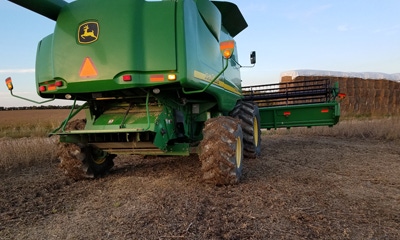
The Kansas fall harvest of 2016 appears to be bountiful, but getting it out of the field in much of the state, especially in the south-central region, has not been pretty.
"It's going to be a challenge getting rid of the ruts and the torn up areas in the fields," says Marion County farmer Paul Penner.
The past summer in southern Kansas can only be described as "wet."
The National Weather Service’s official recording station at Eisenhower National Airport in Wichita shows 30.35 inches of rain from July 1 to Oct. 10, about 18.75 inches above normal for the station. At Chanute in southeast Kansas, rainfall was about 6.5 inches above normal, and at Salina it was about an inch above normal.

MUDDY TIRES: The tires of this combine indicate the sloppy conditions of fall harvest in Marion County in south-central Kansas. (Photo courtesy of Paul Penner.)
Across south-central Kansas, heavy rains caused stream and river flooding that covered thousands of acres of corn and soybeans just a few weeks before harvest. Continued, frequent rains, kept fields too wet to harvest.
In spite of depressed prices, the prospect of bushels in the bin (or the bunker) had most farmers feeling optimistic. The continued delays and issues with getting those bushels out of the field and into the bin have taken the shine off.
For cotton growers, the very wet weather in late summer was not good news, because the cooler and wetter weather threatened both crop maturity and quality. Cotton growers now need both warmer-than-normal weather and a late freeze on the order of last year's Nov. 21, about a month later than the typical "first frost" date.
Along with delaying fall harvest, the persistent wet weather delayed planting for winter wheat and pushed fall tasks closer together.
Adding to the frustration for many farmers, including Penner, was the fact that the crop in the field looked somewhere between very good and downright awesome just a few weeks ago. The longer the harvest delay continued, the more likely it became that yields and quality would be reduced.
Meanwhile, farmers in the west-central and southwest area of the state are worried about a return to drought as conditions during wheat planting are dry enough to create germination problems for the 2017 winter wheat crop.
One thing that can be said of Kansas weather: It is never predictable and never boring.
About the Author(s)
You May Also Like






